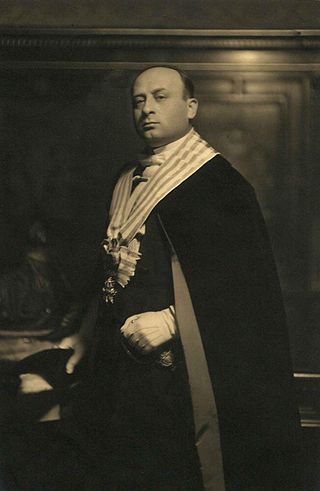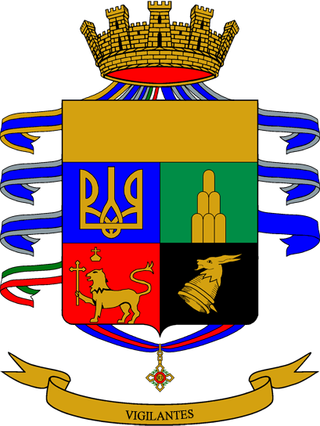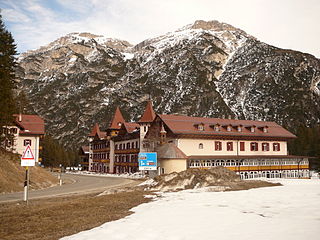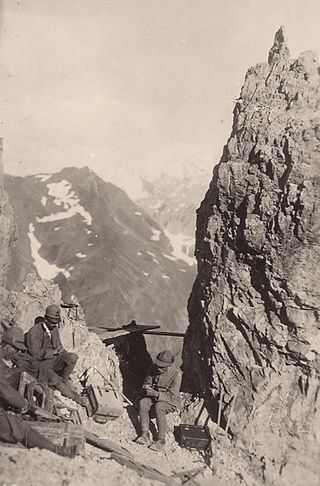
The Brenta is an Italian river that runs from Trentino to the Adriatic Sea just south of the Venetian lagoon in the Veneto region, in the north-east of Italy.

Bassano del Grappa is a city and comune, in the Vicenza province, in the region of Veneto, in northern Italy. It bounds the communes of Cassola, Marostica, Solagna, Pove del Grappa, Romano d'Ezzelino, Campolongo sul Brenta, Conco, Rosà, Cartigliano and Nove. Some neighbourhoods of these communes have become in practice a part of the urban area of Bassano, so that the population of the whole conurbation totals around 70,000 people.

Monte Grappa is a mountain of the Venetian Prealps in Veneto, Italy. It lies between the Venetian plain to the south and the central alpine areas to the north. To the west, it is parted from the Asiago upland by the Brenta river, and to the east it is separated from the Cesen-Visentin massif by the Piave river. To the north lie Corlo lake and Feltre valley. In the past, the mountain was called Alpe Madre, and is currently divided among three provinces: Vicenza to the west, Treviso to the south and Belluno to the northeast. It is the highest peak of a small massif, which also includes many other peaks such as Col Moschin, Colle della Berretta, Monte Asolone, Monte Pertica, Prassolan, Monti Solaroli, Fontana Secca, Monte Peurna, Monte Santo, Monte Tomatico, Meatte, Monte Pallon, and Monte Tomba.

The Quartermain Mountains are a group of exposed mountains in Antarctica, about 20 nautical miles long, typical of ice-free features of the McMurdo Dry Valleys, Victoria Land. They are east of the Lashly Mountains, south of the Asgard Range, west of the Kukri Hills and Royal Society Range, and some distance north of the Worcester Range.

Giuliano Gozi was Secretary for Foreign Affairs and de facto Fascist leader of San Marino from 1918 until 1943. He also held the role of Captain-Regent of San Marino 5 times between 1923 and 1942.

The 2nd Alpini Regiment is a mountain warfare regiment of the Italian Army based in Cuneo in Piedmont. The regiment belongs to the Italian Army's Alpini infantry speciality and is assigned to the Alpine Brigade "Taurinense". On 1 November 1882, the Royal Italian Army formed the 2nd Alpini Regiment, which had its recruiting area in the Maritime Alps and Cottian Alps. During World War I the regiment expanded to ten battalions, which fought separately in the alpine areas of the Italian front. The regiment's anniversary falls on 6 June 1916, the height of the Battle of Asiago, during which four of the regiment's battalions earned a Silver Medal of Military Valor for holding Monte Fior and Monte Castelgomberto.

The 1st Alpini Regiment in an inactive mountain warfare regiment of the Italian Army last based in Pinerolo in Piedmont. The regiment belongs to the Italian Army's Alpini infantry speciality and was last active as Alpini Battalion Mondovì. On 1 October 2022, the flag and traditions of the regiment were assigned to the Command and Tactical Supports Unit "Taurinense" of the Alpine Brigade "Taurinense". On 1 November 1882, the Royal Italian Army formed the 1st Alpini Regiment, which had its recruiting area in the Ligurian Alps and Maritime Alps. During World War I the regiment expanded to nine battalions, which fought separately in the alpine areas of the Italian front. The regiment's anniversary falls on 16 June 1917, the height of the Battle of Mount Ortigara, during which the regiment's battalions earned three Silver Medals of Military Valor.

The 3rd Alpini Regiment is a mountain warfare regiment of the Italian Army based in Pinerolo in Piedmont. The regiment belongs to the Italian Army's Alpini infantry speciality and is assigned to the Alpine Brigade "Taurinense". On 1 November 1882, the Royal Italian Army formed the 3rd Alpini Regiment, which had its recruiting area in the Cottian Alps and Graian Alps. During World War I the regiment expanded to 13 battalions, which fought separately in the alpine areas of the Italian front. The regiment's anniversary falls on 16 June 1915, the day the regiment with the battalions "Pinerolo", "Fenestrelle", "Exilles", and "Susa" conquered the summit of Krn in a night attack.

The 4th Alpini Paratroopers Regiment is a special operations forces regiment of the Italian Army based in Montorio Veronese in Veneto. Originally the regiment belonged to the Italian Army's Alpini infantry specialty, but since 14 July 1996 its personnel also belongs to the Paratroopers infantry specialty. On 1 November 1882, the Royal Italian Army formed the 4th Alpini Regiment, which had its recruiting area in the Graian Alps and Pennine Alps. Since 2013 the regiment is assigned to the Army Special Forces Command. The regiment is one of the most often and one of the highest decorated regiments of the Italian Army, although its two Gold Medals of Military Valor were awarded to the regiment's currently inactive Alpini Battalion "Aosta", respectively the currently active Battalion "Monte Cervino". During World War I the regiment expanded to ten battalions, which fought separately in the alpine areas of the Italian front. The regiment's anniversary falls on 18 May 1917, the day the regiment's Alpini Battalion "Aosta" stormed and held the summit of Monte Vodice during the Tenth Battle of the Isonzo.

The Alpine Brigade "Cadore" was a light Infantry brigade of the Italian Army, specializing in mountain warfare. Its core units were Alpini, the mountain infantry corps of the Italian Army, that distinguished itself in combat during World War I and World War II. The brigade was based in the Italian provinces of Belluno and Vicenza with its headquarters Belluno. The brigade was disbanded in 1997.

The 6th Alpini Regiment is a mountain warfare training regiment of the Italian Army based in Bruneck in South Tyrol. The regiment belongs to the Italian Army's Alpini infantry speciality and is assigned to the Alpine Training Center in Aosta. On 1 November 1882, the Royal Italian Army formed the 6th Alpini Regiment, which had its recruiting area initially in the Vicentine Alps, Bellunes Alps, Carnic Alps, Carnic Prealps, and the Western side of the Julian Alps. In 1887 the regiment was split to form the 7th Alpini Regiment and afterwards the regiment's recruiting area consisted of the Vicentine Alps. During World War I the regiment expanded to ten battalions, which fought separately in the alpine areas of the Italian front. The regiment's anniversary falls on 10 June 1917, the height of the Battle of Mount Ortigara, during which four of the regiment's battalions earned a Silver Medal of Military Valor.

The Alpini Paratroopers Battalion "Monte Cervino" is a tier 2 Italy's special operations forces unit of the Italian Army.

The Alpini are a mountain infantry corps of the Italian Army, that distinguished itself in combat during World War I and World War II. They are also famous in Italy for their songs and choirs.

The Battles of Monte Grappa were a series of three battles which were fought during World War I between the armies of the Austro-Hungarian Empire and the Kingdom of Italy for control of the Monte Grappa massif, as it covered the left flank of the Italian Piave front.

The Comando Truppe Alpine or COMTA commands the Mountain Troops of the Italian Army, called Alpini and various support and training units. It is the successor to the 4º Corpo d'Armata Alpino of the Cold War. The Alpini are light Infantry units specializing in Mountain Combat. The subordinate units of the COMTA distinguished themselves during combat in World War I and World War II.

The Ponte Vecchio or Ponte degli Alpini is the covered wooden designed by the architect Andrea Palladio in 1569. The bridge is located in Bassano del Grappa and was destroyed many times, the last time in World War II. The bridge spans the river Brenta.

Monte Piana is a 2,324-metre (7,625 ft) tall mountain in the Sexten Dolomites and located on the border between the provinces of South Tyrol and Belluno. The smaller Northern summit of the mountain is named Monte Piano (2,305m).

The Alpini are a specialised mountain warfare infantry corps of the Italian Army, which distinguished itself in World War I fighting in the Alps against Austro-Hungarian Kaiserjäger and the German Alpenkorps. The Alpini were supported by the Mountain Artillery, which both share the Cappello Alpino as identifying symbol. Below follow tables listing the regiments, battalions and groups, companies and batteries of the Alpini and Mountain Artillery active in World War I.

The military memorial of Monte Grappa is the largest Italian military ossuary of the First World War. It is located on the summit of Monte Grappa between the provinces of Treviso and Vicenza, at 1,776 meters above sea level. Access to the memorial is via the Strada Cadorna, built by the army on the orders of General Luigi Cadorna to bring construction materials for the fortification on Monte Grappa in 1917.

Monte Fior is a mountain of Veneto, Italy. It is located on the Asiago Plateau, in the Vicentine Alps, and has an elevation of 1,824 metres (5,984 ft).




















